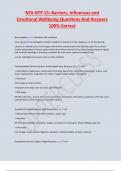NTA NTP 15: Barriers, Influences and Emotional Wellbeing Questions And Answers 100% Correct Neuroception -situational risk evaluation -how neural circuits distinguish whether situations or people are safe, dangerous or life threatening -process is initiated by our sense organs, which then communicates with lightning speed to our brain, central and peripheral nervous system which then informs the rest of our body through electrical signals and chemical messengers, directing us towards the next action required to keep us safe -can be maladapted and cause over or under -reactions Parasympathetic Nervous System: Dorsal Vagal Freeze Response "I can't" =>Overwhelm: helplessness, conservation of energy, depression, numbness, dissociation, shame, shut -
down, hopelessness, preparation for death, trapped, body collapse, immobility =>Increases: fuel storage & insulin activity endorphins that help numb and raise pain threshold =>Decreases: HR, BP , body temp., muscle tone, facial expressions, eye contact, intonations, awareness of human voice, social behavior, sexual responses, immune response Sympathetic Nervous System: Fight Response "I can" =>Movement Towards: frustration, irritation, anger, rage =>Increases: BP , HR, fuel availability, adrenaline, oxygen, circulation to vital organs, blood clotting, pupil size =>Decreases: fuel storage, insulin activity, digestion, salivation, relational ability, immune response Sympathetic Nervous System: Flight Response "I can" NTA NTP 15: Barriers, Influences and Emotional Wellbeing Questions And Answers 100% Correct =>Movement Away: worry & concern, anxiety, fear, panic =>Increases: BP , HR, fuel availability, adrenaline, oxygen, circulation to vital organs, blood clotting, pupil size =>Decreases: fuel storage, insulin activity, digestion, salivation, relational ability, immune response Parasympathetic Nervous System: Ventral Vagal Social Engagement joy, curiosity/openness, in the present, groundedness, connection -safety, oriented to environment, compassion, mindful =>Increases: digestion, intestinal motility, resistance to infection, rest & recuperation, circulation to non -vital organs (skin, extremities), oxytocin (bonding neurotransmitter, immobility without fear), ability to relate & connect =>Decreases: defensive responses Internal Challenges & Biases: Imposter Syndrome -The crippling feeling of self -doubt, intellectual inadequacy, and anticipated failure that haunts people who attribute their success to luck or help from others rather than their own abilities (Nelson, 2011). -The temptation here is to believe the internal narrative that you are less than, not enough, and should therefore contract and limit your engagements with your client. Internal Challenges & Biases: Responding to Fear -Recognize it and gently bring inquiry to its message, to then shift your focus to what your heart is saying behind the f_____ -narrative at that moment. -Recognition of your _______ at any given moment is not giving in to __________. -On the contrary, it is a call to action. -Recognize ______ for what it is trying to do, to keep you safe and comfortable.




